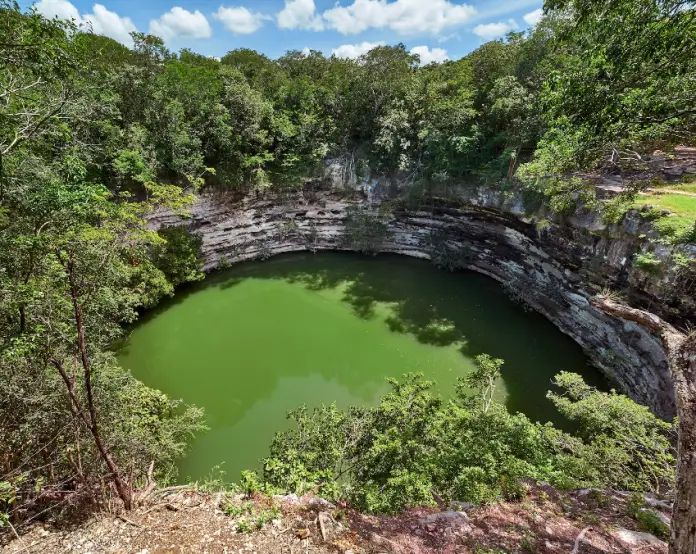The true significance of cenotes for the ancient Maya is shrouded in mystery. Were they sacred? Were they used for rituals? Did they receive human sacrifices?
Below the calm, crystal-clear waters of this interconnected network of natural sinkholes, gruesome evidence points toward a sacred past. To link the pieces of the puzzle, researchers dive into the depths of the Maya underworld, known as Xibalba, to reveal the secrets of this fascinating civilization.

Thousands of cenotes dot the Yucatán Peninsula, yet many are unexplored and likely still hold keys that could unlock knowledge lost to the ages. However, one critical archaeological site that provides some answers is the Sacred Cenote of Chichén Itzá. For decades, scientists have uncovered remains that continue to shed light on a story with many missing parts.
The 14-meter-deep waters of the Sacred Cenote are the final resting place for over 200 victims of ritual sacrifice some 1000 years ago. Almost half were children, averaging between the ages of four and six. There were fewer females than males, a myth-buster on the false rampant sacrifice of women virgins suggested by colonial Spanish sources. Yet practically all the skulls and other skeletal remains were found with varying degrees of mutilation, virtually certifying the Sacred Cenote as a prolific sacrificial site.
Powdery sand at its base was curiously covered in a blue tint, later discovered to have washed off human bodies and other offerings. The pigment, known as Maya blue, was made and used primarily by Mesoamerican cultures during a period extending from about the eighth century until just after the mid-19th century. Fantastic pre-Columbian murals and pottery fragments discovered around archaeological sites show evidence that the color was exclusive to the gods or those chosen for ritual sacrifice. Furthermore, studies show the Maya often applied the revered pigment when depicting Cháak, the god of rain who lived in the cenote underworld.
In 2019, American archaeologist T. Douglas Price and two co-authors published a groundbreaking study on skulls from the Sacred Cenote showed that human sacrifices were “sourced from far and wide across Mexico”. According to the research paper, the Maya city was a ceremonial center that included violent rituals with mutilation, disarticulation and methods of public display.

“Hundreds of people were ritually executed and their bodies thrown into the waters of the Sacred Cenote at Chichén,” writes Price and his co-authors . “The ancient city was one of the most important in the Maya area, but its origins and history are poorly understood. A major question concerns the origins of the peoples who founded and later expanded the ancient city.”
The authors say it is unknown if all sacrificial victims resided in Chichén Itzá, but their suggested origins likely reflect patterns of population movement.
“There were social networks that existed between Chichén Itzá and both neighboring and distant regions,” they write. “Various lines of evidence point to places in the Yucatán, along the Gulf Coast, Central America, or even in the Central Highlands of Mexico.”
Another article that references T. Douglas Price’s study noted “that many bones appeared weathered, as if displayed and exposed to the elements before being cast into the cenote. Some skulls also had holes on either side near the temple that could only have been made by a percussive tool.”

This collaborative study boosts the theory that Postclassic Maya influence was more far-reaching and widespread throughout Mesoamerica than first perceived. The remains and artifacts dredged from the Sacred Cenote are exhibited at the Peabody Museum at Harvard University and the National Museum of Anthropology in Mexico City.
A cenote was considered the realm of powerful guardian spirits who protected humans but was also considered the only source responsible for life-giving rain. Rituals are still conducted with offerings to the same spirits responsible for the rain that gave good harvests for their ancestors. The Sacred Cenote of Chichén Itzá is not the only sinkhole containing secrets that explain the complexity of Mexico’s ancient civilizations. The depths of the Xibalba underworld, accessed from thousands of unique vertical cave spots around Yucatán, hold more answers yet to be discovered.
Mark Viales writes for Mexico News Daily.
